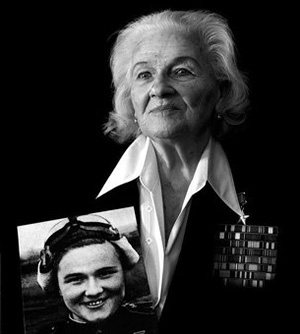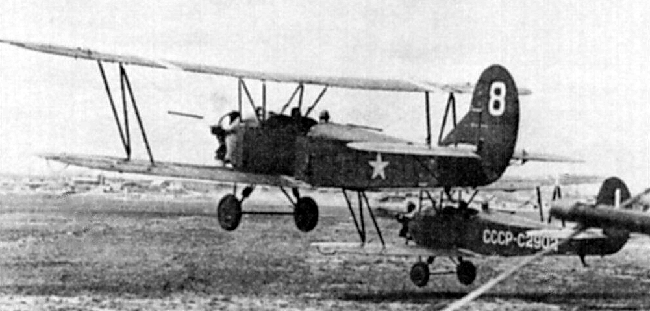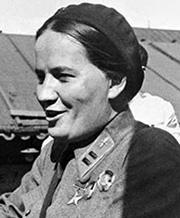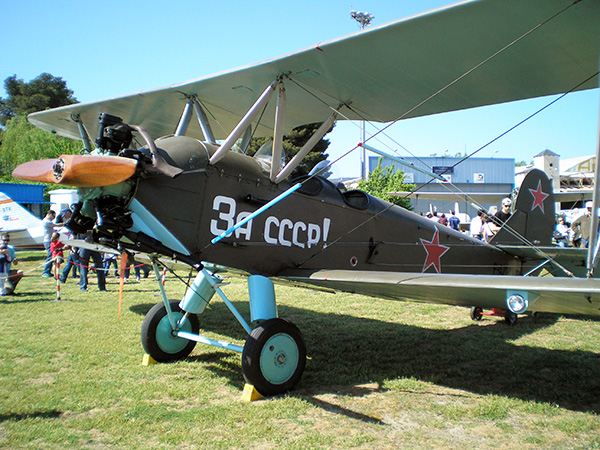Nadezhda Popova
Today, Nadia Popova. The University of Houston's College of Engineering presents this series about the machines that make our civilization run and about the people whose ingenuity created them.
 I write this in July, 2013. Nadia Popova has just died at age 91. Popova was a Russian woman who'd wanted to be a singer and an actress. WW-II intervened; and, instead of singing, she joined the 588th Night Bomber Regiment. She flew an incredible 852 missions.
I write this in July, 2013. Nadia Popova has just died at age 91. Popova was a Russian woman who'd wanted to be a singer and an actress. WW-II intervened; and, instead of singing, she joined the 588th Night Bomber Regiment. She flew an incredible 852 missions.
Years ago I did a program about her regiment. But there's much more to tell. The group had as many as 40, two-women crews. And the airplanes they flew! Polikarpov Po-2s, called Kukuruzniks. Kukuruznik means crop-duster, and that's what those primitive planes really were.
Some 30,000 Po-2s were made between 1928 and '52. They were old two-seater, open-cockpit, wood-and-fabric, biplanes if you can believe it! No radios; no parachutes. And they were up against Messerschmitt and Focke-Wolf fighter planes. That might sound like suicide for those women. But consider their tactics.

Period photo of Polikarpov Po-2, "Kukuruzniks" taking off
They flew night bombing raids over nearby enemy lines. They carried only half a ton or so. But they managed to harass and demoralize the Germans. They would cut their engines and glide in low. The enemy heard only a swoosh, then an explosion. Small wonder they called the women Nachthexen or Night Witches.
The Po-2's cruising speed was 68 miles an hour. And German fighters stalled at around 120 miles an hour. Sure, they'd were toast if a fighter got them in its sights, but that was hard to do. The Po-2 was slow but nimble. German planes were too fast to stay on their tails or keep up with their turns. Fighter planes were less of a threat than ground-fire in this kind of warfare.
They flew in groups of three. Two planes served as decoys to draw fire, while a third slipped in to drop its bombs. Then they'd switch positions until all three had dropped their bombs.
It was grueling for this small band of sisters. They flew 23,000 sorties, sometimes ten a night. They dropped 3000 tons of bombs from their tiny planes. And 30 of the women died in combat.
 Popova's group had been formed by 30-year-old Marina Raskova. Raskova had also begun as a singer. She pursued it until the stress, not of flying but of singing, was too much for her. Then she took up chemistry, drafting, and finally flying. Raskova joined the Russian Air Force where she set a distance record in a bomber and worked as a flight instructor. Then, a few months after she formed the 588th, she died in a crash.
Popova's group had been formed by 30-year-old Marina Raskova. Raskova had also begun as a singer. She pursued it until the stress, not of flying but of singing, was too much for her. Then she took up chemistry, drafting, and finally flying. Raskova joined the Russian Air Force where she set a distance record in a bomber and worked as a flight instructor. Then, a few months after she formed the 588th, she died in a crash.
Popova also suffered a crash on a daring rescue mission for trapped Russian soldiers. But she survived, met her future husband among the soldiers, and lived to become a great-grandmother.
Is she the last of these women? I'm not sure. But I doubt any will be around when this program reaches reruns. One way or another, a remarkable chapter of the most awful war ever fought is ending.
I'm John Lienhard at the University of Houston, where we're interested in the way inventive minds work.
I've referred to Pedrova as Nadia, as she was called. Her name was actually Nadezhda. The numbers reported for missions flown, tons of bombs dropped, etc. vary, depending on what you read. I've given what appear to be the best numbers. Here are my web sources:
New York Times article on Popova
Wikipedia article on the Polikarpov Po-2 Seize the Sky artlcle on the Night Witches
NPR Audio story on Popova
Wikipedia article on Raskova
H2G2's article on the Night Witches
Article from The Atlantic on the Night Witches
A. Noggle, A Dance With Death: Soviet Airwomen in World War II. (College Station, TX: Texas A&M University Press, 1994). See also this 1995 episode based upon Noggle's book.
The Po-2 was not the only antediluvian Polikarpov airplane that saw action in WW-II. See also this Engines episode about the more advanced Polikarpov I-152.

Present-day photo of a Polikarpov Po-2 in USSR colors
All images are courtesy of Wikimedia Commons
This episode was first aired on July 23, 2013